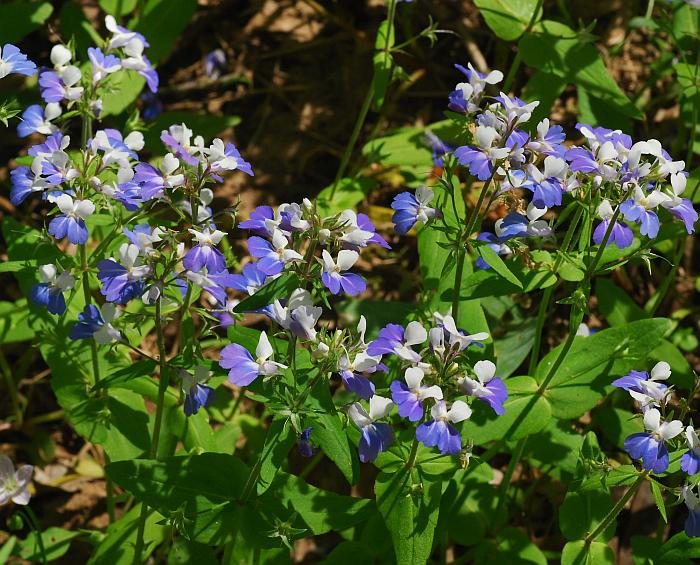Collinsia verna Nutt.
Blue-Eyed Mary

Native
CC = 7
CW = 3
MOC = 40
© SRTurner
Collinsia verna Nutt.Blue-Eyed Mary | |
 |
Native CC = 7 CW = 3 MOC = 40 |
© SRTurner |
|
Family - Plantaginaceae Habit - Taprooted annual forb. Stems - Erect, to 40 cm, single or multiple from base, sometimes branched, hollow, with two opposing longitudinal lines of pubescence below, scattered glandular-hairy toward the tips.
Leaves - Opposite, simple, unlobed, the uppermost sessile and clasping the stem, grading into the lower, short- to long-petiolate ones. Leaf blades variously lanceolate to oblong, elliptic, or ovate (lowermost leaves sometimes broadly ovate to nearly circular), rounded or bluntly to sharply pointed at the tip, the margins otherwise entire to shallowly scalloped or toothed, the surfaces glabrous or sparsely and minutely hairy toward the base of the midvein, the venation pinnate, but the lateral veins sometimes very faint. Lowest leaf blades to 2 cm long, 1.5cm broad. Upper leaf blades to 5 cm long, 2 cm broad.
Inflorescence - Terminal racemes, often appearing axillary because of the pair of leaflike bracts at each node, the flowers opposite or whorled at the nodes, long-stalked. Bractlets absent. Pedicels 9-25 mm long in flower, much elongated in fruit, pubescent.
Flowers - Calyces bell-shaped, 5-lobed, 3.5-5.0 mm long, persistent in fruit. Lobes nearly equal, to 4 mm long, 2-3 mm broad at base, mostly glabrous. Corollas bilabiate, tubular, 10-14 mm long, the lobes shallowly (0.5-1.0 mm) notched, the upper lip about as long as the lower one, white or occasionally faintly bluish-tinged, the lower lip blue to purplish blue, broader than upper lip, sometimes with a longitudinal, white stripe or line on each lateral lobe. Stamens 4, borne at base of corolla tube, one pair from upper lip, one pair from lower lip (didynamous). Filaments white, glabrous, to 6 mm long. Anthers of stamens from lower lip yellow, to 1 mm long. Anthers of stamens from upper lip brownish, to 1 mm long. Style filiform, to 5 mm long. Ovary globose, 4-valved.
Fruits - Globose capsules 4-6 mm in diameter, glabrous. Seeds usually 4 per fruit, 2.5-3.2 mm long.
Flowering - April - June. Habitat - Bottomland forests, streambanks, bluff bases. Origin - Native to the U.S. Lookalikes - Collinsia violacea. Other info. - This delightful member of the springtime ephemeral flora has a somewhat unusual distribution, being most common in the middle latitudes of the state. Outside of Missouri, its main range is the upper Midwest. When in bloom it is easily recognized by its bright blue and white flowers. It puts on a beautiful display for a plant of its size. A second species, C. violacea, looks similar but with purple lower petal lips. Note that the color of the corolla is not definitive, since C. verna populations will almost always have a few plants with purplish flowers. A better character is the shape of the corolla lobes, which in C. violacea are deeply notched. The plant should be considered for cultivation in rich, moist, shaded areas. Under favorable conditions it can form vast carpets of blue and white. Photographs taken at Eagle Bluffs Conservation Area, 4-11-04, and off the Katy Trail, Callaway County, MO., 4-22-04 (DETenaglia); also at Little Lost Creek Conservation Area, Warren County, MO, 5-12-2013 and 4-14-2021, and Washington State Park, Washington County, MO, 4-18-2016 (SRTurner). |